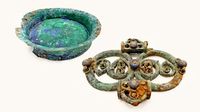Archaeologists have announced the discovery of what is being hailed as one of the "largest and most important" Iron Age finds in the UK—the Melsonby Hoard, located in a field near Melsonby, North Yorkshire. This extraordinary hoard consists of more than 800 items, including two ornate cauldrons, ceremonial spears, horse harnesses, bridle bits, and an impressive count of 28 iron tyres, believed to have been buried around 2,000 years ago.
The hoard was unearthed by metal detectorist Peter Heads, who reported his finding to the authorities in December 2021. Following the discovery, a collaborative excavation took place in 2022 with support from Durham University, the British Museum, and a significant £120,000 grant from Historic England.
Experts describe the Melsonby Hoard as an unprecedented find that could lead to a "major reevaluation" of wealth and status among the northern elites of Britain during the Iron Age. Tom Moore, head of Durham University's archaeology department, remarked on the significance of this discovery, stating, "The size and scale of the find is exceptional for Britain and probably even Europe." He noted that these artifacts suggest that the wealth in northern England during that time was previously underestimated, adding that the original owner of these items was likely part of a network of elites extending across Britain, into Europe, and even to the Roman world.
Noteworthy about the hoard is the analysis indicating that many items appear to have been purposefully burnt or broken before their burial, a practice reflecting the power and status of their original owner. Moore posited, "The destruction of so many high-status objects is also of a scale rarely seen in Iron Age Britain and demonstrates that the elites of northern Britain were just as powerful as their southern counterparts." Although no human remains were discovered at the site, the form of many artifacts could suggest that they were part of a funerary tradition.
The artifacts are now under analysis at Durham University, where archaeologists are buzzing with excitement. At the excavation site, experts retrieved various components including the partial remains of over seven four-wheeled wagons or two-wheeled chariots as well as elaborate harnesses for at least 14 ponies. Some of these harnesses were adorned with red Mediterranean coral and colored glass, emphasizing the wealth and status of the individuals who owned them. Moore stated, "They would have looked incredible," further indicating that this reflects a level of sophistication not previously associated with the Iron Age people of northern England.
In addition to the wagon components, the hoard features ceremonial spears and two distinctive cauldrons, one decorated in styles that appeal both to Mediterranean aesthetics and Iron Age culture, likely serving as a mixing bowl for wine. These findings establish a tangible link to the broader trading networks connecting northern England with continental Europe and the burgeoning Roman Empire.
The British Museum supported this excavation, regarding it as an internationally important discovery. Duncan Wilson, chief executive of Historic England, expressed enthusiasm about the find, stating, "This is one of the most important and exciting Iron Age period discoveries made in the UK." He asserted that it has the potential to provide new insights into life during the Iron Age in the northern part of the country, while also showcasing connections to Europe.
Moreover, the Yorkshire Museum is set to launch a fundraising campaign aimed at securing the hoard for public viewing. Senior curator Andrew Woods emphasized, "This Iron Age hoard is an unprecedented find in the north, which will help us to understand more about this remarkable period in our history." The museum has scheduled a display of selected artifacts from the hoard to commence from March 25, 2025.
Experts like Keith Emerick, inspector of ancient monuments at Historic England, continue to marvel at the scale and beauty of the artifacts. Reflecting on the discovery, Emerick recalled, "To have something like this from the north of England is really exceptional," reiterating the find's significance in changing perceptions about the wealth and sophistication of northern Britain during the Iron Age.
In summary, the Melsonby Hoard does not merely represent a collection of objects; it is a treasure trove of insights that could reshape our understanding of ancient wealth, trade, and social status among the tribes of Britain. As historians continue to analyze its contents, the Melsonby Hoard is poised to rewrite narratives about Iron Age Britain and further connect northern elites with their counterparts in the south and across Europe. With the excitement bubbling at Durham University and its forthcoming public exhibition, many eagerly anticipate learning more about the stories these ancient artifacts will reveal.






